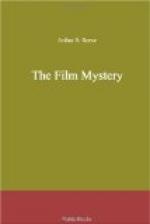In the scene she changed. Marilyn Loring was an actress. The moment she caught the click of the camera’s turn there was a hardness about her mouth, a faint dishonest touch to the play of her eye, a shameless boldness to her movements concealed without concealment. In the flash of a second she was Marilyn no longer, but Zelda, the ward of old Remsen, an unscrupulous and willing ally of the “Black Terror.”
Werner damned the amount of footage used in the scene, then turned to the next, with Enid and Gordon, in the same set, one of the necessary retakes for which the room had been put up again.
Enid had not noticed me and I somehow failed to shake off the feeling of fear that the glance of Millard had given me. Faint heart I was, and the answer was that I had yet to win the fair lady. To excuse myself I pretended she was different under the lights. It was really true that, as Zelda Remsen, Enid was not the fascinating creature I had met in Werner’s office. There was too much Mascaro on her lashes, too great an amount of red and blue and even bright yellow in her make-up. In striking contrast was the little coloring used by Stella Lamar, or even Marilyn Loring.
Enid’s scene was a close-up in which the beginning of the love interest in the story was shown. I noticed that as the cameras turned upon the action the girl inch by inch shifted her position, almost imperceptibly, until she was practically facing the lens. The consequence was that Gordon, playing the lover, was forced to move also in order to follow her face, and so was brought with his back toward the camera. It was the pleasant little film trick known as “taking the picture away” from a fellow actor. Enid was a “lens hog.”
The moment the scene was over Gordon rushed to Werner to protest. The director, irritated and in a hurry, gave him small satisfaction. Both players were called back under the lights for the next “take.” As Werner’s back was turned Enid favored Gordon with a mischievous, malicious glance. The leading man possessed very few friends, from what I had heard. The new star evidently did not propose to become one of them.




